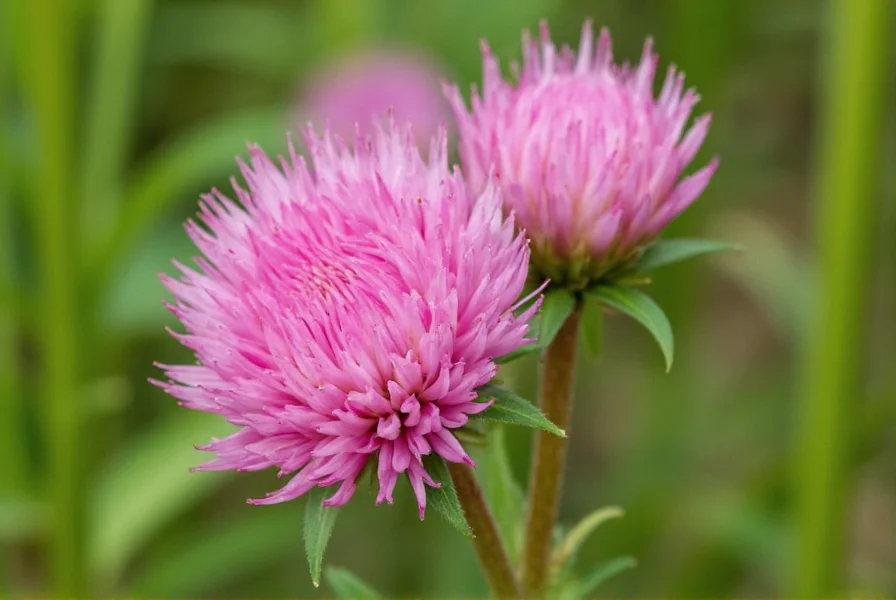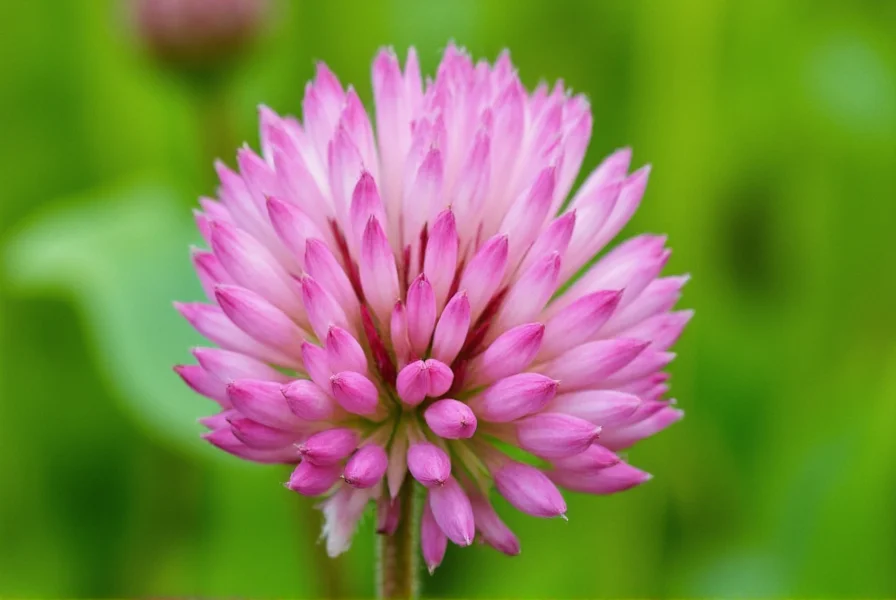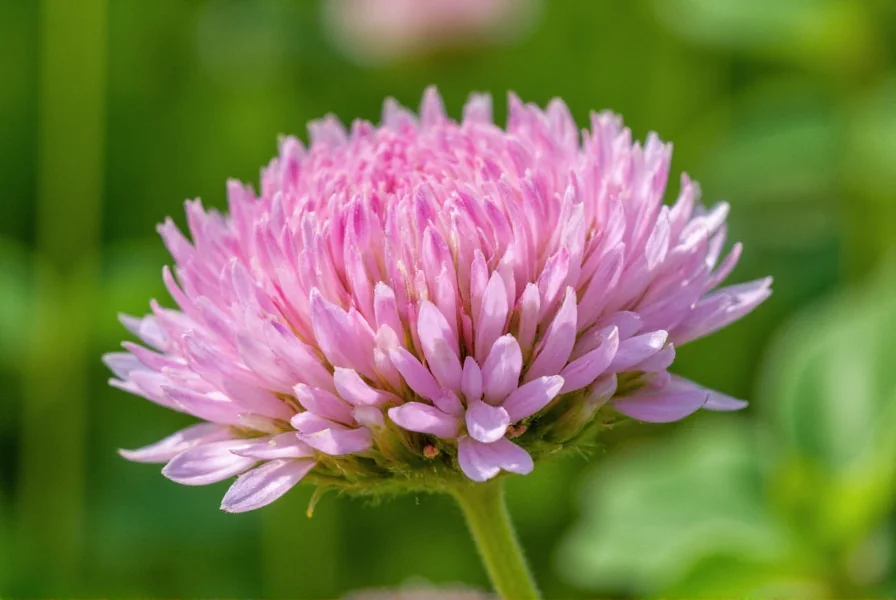Understanding the botanical and practical aspects of red clover (Trifolium pratense) requires examining its complete biological profile, historical applications, and contemporary uses. This comprehensive overview provides scientifically accurate information about this versatile plant species that has played significant roles in both agricultural systems and herbal medicine traditions worldwide.
Botanical Classification and Physical Characteristics
Red clover belongs to the Fabaceae (legume) family and is scientifically designated as Trifolium pratense L. The "L." denotes its formal description by Carl Linnaeus, the father of modern taxonomy. This herbaceous plant typically grows 20-80 cm tall with hollow stems and alternate leaves composed of three oval leaflets, each featuring a distinctive pale crescent or "water mark" pattern.
The most recognizable feature of red clover trifolium pratense is its dense, globe-shaped flower head containing numerous individual pea-like flowers that range from pink to purple. These blossoms contain high concentrations of isoflavones, particularly biochanin A and formononetin, which convert to genistein and daidzein in the human body. The plant's root system includes both taproots and lateral roots with nitrogen-fixing root nodules containing Rhizobium bacteria.

Habitat and Cultivation Requirements
Native to Europe, Western Asia, and northwest Africa, red clover trifolium pratense has been introduced to many other regions including North America, where it has naturalized in fields, roadsides, and meadows. This adaptable plant thrives in temperate climates and prefers well-drained, loamy soils with a pH between 6.0 and 7.0, though it demonstrates reasonable tolerance to various soil conditions.
Successful red clover cultivation requires consideration of several factors:
| Growth Factor | Optimal Conditions | Tolerance Range |
|---|---|---|
| Soil Type | Loamy, well-drained | Moderate clay tolerance |
| pH Level | 6.0-7.0 | 5.5-7.5 |
| Sun Exposure | Full sun | Partial shade (reduced yield) |
| Moisture | Moderately moist | Drought-sensitive; poor in waterlogged soils |
Gardeners and farmers interested in red clover trifolium pratense cultivation should note that this plant typically functions as a biennial or short-lived perennial, often lasting 2-3 years in agricultural settings. It establishes best when planted in early spring or late summer, with seeds requiring light for germination and thus should be sown shallowly.
Historical and Traditional Applications
Red clover's historical significance spans multiple cultures and continents. European herbalists traditionally used red clover trifolium pratense preparations for respiratory conditions, skin disorders, and as a general detoxifying agent. Native American tribes incorporated the plant into various medicinal practices, while traditional Chinese medicine recognized its properties for clearing heat and resolving toxicity.
During the 19th century, red clover became a key component in the "Eclectic" medical movement in North America, where practitioners prescribed it for lymphatic system support and as an alterative (blood purifier). The plant's use in folk medicine for treating whooping cough earned it the common name "pulema" in some regions. Traditional red clover trifolium pratense preparations typically involved infusions of the flowering tops for internal use or poultices for external applications.
Modern Research and Evidence-Based Applications
Contemporary scientific interest in red clover trifolium pratense primarily focuses on its isoflavone content and potential health benefits. Research has examined its effects on several health conditions:
- Menopausal symptoms: Several clinical trials suggest red clover isoflavones may modestly reduce hot flash frequency and severity, though results remain somewhat inconsistent across studies examining red clover trifolium pratense for menopause management
- Cardiovascular health: Preliminary research indicates potential benefits for arterial flexibility and lipid profiles, though more extensive human trials are needed to confirm these red clover medicinal uses
- Skin health: Topical applications of red clover extracts show promise for improving skin elasticity and hydration in early-stage research
- Antioxidant properties: The plant demonstrates significant free radical scavenging activity in laboratory studies
It's important to note that while traditional red clover trifolium pratense applications are numerous, scientific evidence supporting many specific health claims remains limited. Most research has focused on standardized extracts rather than whole-plant preparations commonly used in traditional medicine.

Agricultural Significance and Ecological Benefits
Beyond medicinal applications, red clover trifolium pratense serves important agricultural functions. As a nitrogen-fixing legume, it improves soil fertility without synthetic fertilizers, making it valuable in crop rotation systems. Farmers have long used this plant as high-quality forage for livestock, particularly for dairy cattle, due to its protein content and palatability.
Ecologically, red clover supports pollinator populations, particularly bees, which are attracted to its nectar-rich flowers. Its deep root system helps prevent soil erosion and improves soil structure. In sustainable agriculture systems, red clover trifolium pratense often functions as a green manure crop, with farmers plowing the plants back into the soil to enhance organic matter content.
Safety Considerations and Potential Interactions
While generally considered safe when used appropriately, red clover trifolium pratense may cause side effects in some individuals. Mild gastrointestinal discomfort represents the most commonly reported issue. More significantly, due to its isoflavone content, red clover may interact with certain medications and health conditions:
- Individuals with hormone-sensitive conditions (such as breast cancer, uterine cancer, ovarian cancer, endometriosis, or uterine fibroids) should avoid red clover trifolium pratense without medical supervision
- Red clover may enhance the effects of blood-thinning medications like warfarin
- Pregnant and breastfeeding women should avoid medicinal use of red clover due to insufficient safety data
- Surgical patients should discontinue red clover at least two weeks before procedures due to potential bleeding risks
As with any herbal preparation, consulting a healthcare provider before using red clover trifolium pratense medicinally is advisable, especially for individuals with pre-existing health conditions or those taking prescription medications.
Identification and Differentiation from Similar Species
Accurate identification of red clover trifolium pratense is essential, particularly for foragers and herbalists. Key distinguishing features include:
- Flower color: Pink to purple (never true red)
- Leaf markings: Distinctive pale crescent or "water mark" on each leaflet
- Flower structure: Dense, spherical flower heads containing numerous individual flowers
- Stem: Hollow and softly hairy
Red clover is often confused with white clover (Trifolium repens), which has white or pink-tinged flowers, creeping growth habit, and smaller leaves without prominent water marks. Crimson clover (Trifolium incarnatum) features darker red flowers and more pointed leaflets. Proper identification of red clover trifolium pratense prevents accidental consumption of potentially toxic look-alikes.











 浙公网安备
33010002000092号
浙公网安备
33010002000092号 浙B2-20120091-4
浙B2-20120091-4